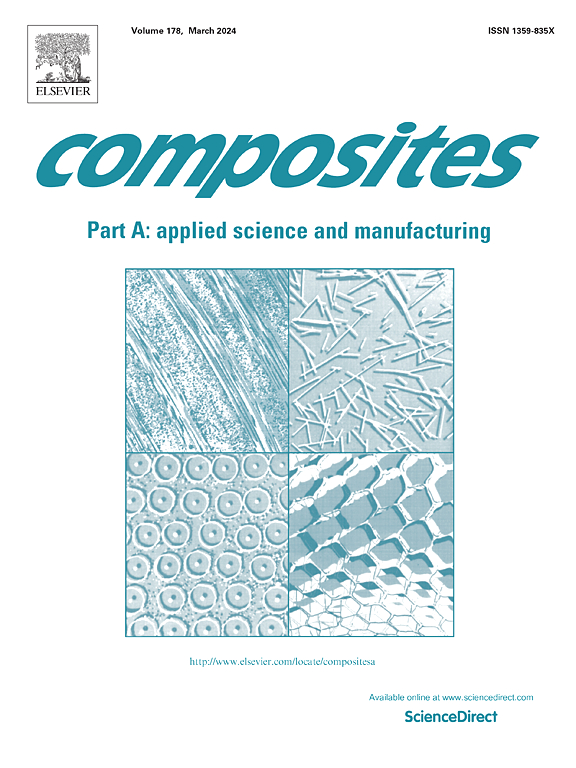通过分离氮化硼纳米片提高聚合物复合膜的导热性和介电性能
IF 8.1
2区 材料科学
Q1 ENGINEERING, MANUFACTURING
Composites Part A: Applied Science and Manufacturing
Pub Date : 2025-02-12
DOI:10.1016/j.compositesa.2025.108802
引用次数: 0
摘要
导热纳米填料与聚合物基体之间的高界面热阻(ITR)和纳米填料缺乏良好的取向性是制约其在聚合物纳米复合材料中发挥其固有导热性能的主要因素。因此,开发纳米填料的超高热导率涉及开发最小化ITR的方法或机制。本文采用顺序单向冷冻铸造(UFC)技术制备了氮化硼纳米片(BNNS)/聚乙烯醇(PVA)纳米复合膜,BNNS之间具有分离诱导互连。首先通过UFC制备PVA气凝胶,然后将功能化的BNNS渗透到其孔隙和微通道中,然后进行第二次UFC处理。复合气凝胶随后被热压以压缩可用的孔隙通道,以减少因分离的BNNS细胞壁之间更好的接触而产生的ITR。得到的分离BNNS/PVA (SBP)纳米复合膜的导热系数为5.2 W/mK,比常规UFC制备的分散BNNS纳米复合膜的导热系数高约267%。SBP薄膜还具有很高的电绝缘特性,并且在1 kHz频率下具有非常低的10-2介电损耗,这些特性直接来自于分离的BNNS。序贯UFC为微电子和集成电路的热管理提供了一种有效的方法,通过隔离来整合对齐和互连的BNNS,以增强其导热性和电阻率。本文章由计算机程序翻译,如有差异,请以英文原文为准。

Enhancing the thermal conductivity and dielectric properties of polymer composite film through segregated boron nitride nanosheets
High interfacial thermal resistance (ITR) between thermally conductive nanofillers and polymer matrix, and lack of good orientation of nanofillers are primary limiting factors in harnessing their inherent thermal conductivity in polymer nanocomposites. Thus, exploiting ultrahigh thermal conductivities of nanofillers involves developing methods or mechanisms that can minimize the ITR. In this work, boron nitride nanosheets (BNNS)/polyvinyl alcohol (PVA) nanocomposite films with segregation-induced interconnection among BNNS are fabricated by a sequential unidirection freeze-casting (UFC) technique. A PVA aerogel is first made by UFC followed by infiltrating functionalized BNNS into its pores and microchannels which is subjected to a second UFC process. The composite aerogel is subsequently hot pressed to compact the available pore channels for reduced ITR arising from better contact between the segregated BNNS cell walls. The resulting segregated BNNS/PVA (SBP) nanocomposite film with 40 wt% BNNS exhibits high thermal conductivity of 5.2 W/mK, which is about 267 % higher than the nanocomposite film containing dispersed BNNS made by conventional UFC. The SBP film also possessed high electrical insulation characteristics and a very low dielectric loss of at a frequency of 1 kHz, properties arising directly from the segregated BNNS. The sequential UFC provides an effective method to incorporate aligned and interconnected BNNS through segregation for enhanced thermal conductivity and electrical resistivity for thermal management in microelectronics and integrated circuits.
求助全文
通过发布文献求助,成功后即可免费获取论文全文。
去求助
来源期刊

Composites Part A: Applied Science and Manufacturing
工程技术-材料科学:复合
CiteScore
15.20
自引率
5.70%
发文量
492
审稿时长
30 days
期刊介绍:
Composites Part A: Applied Science and Manufacturing is a comprehensive journal that publishes original research papers, review articles, case studies, short communications, and letters covering various aspects of composite materials science and technology. This includes fibrous and particulate reinforcements in polymeric, metallic, and ceramic matrices, as well as 'natural' composites like wood and biological materials. The journal addresses topics such as properties, design, and manufacture of reinforcing fibers and particles, novel architectures and concepts, multifunctional composites, advancements in fabrication and processing, manufacturing science, process modeling, experimental mechanics, microstructural characterization, interfaces, prediction and measurement of mechanical, physical, and chemical behavior, and performance in service. Additionally, articles on economic and commercial aspects, design, and case studies are welcomed. All submissions undergo rigorous peer review to ensure they contribute significantly and innovatively, maintaining high standards for content and presentation. The editorial team aims to expedite the review process for prompt publication.
 求助内容:
求助内容: 应助结果提醒方式:
应助结果提醒方式:


